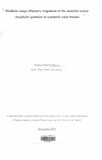| dc.contributor.author | Okumu, Fredros O | |
| dc.date.accessioned | 2013-03-18T06:42:46Z | |
| dc.date.issued | 2008 | |
| dc.identifier.citation | Master of Science degree in Applied Parasitology | en |
| dc.identifier.uri | http://erepository.uonbi.ac.ke:8080/xmlui/handle/123456789/14308 | |
| dc.description.abstract | The interaction between the malaria vector Anopheles gambiae and its human host is
mediated mainly by olfactory cues that emanate from the host. Several compounds from
whole body odor, sweat and breath are proven mosquito kairomones. Medium range
olfactory responses of An. gambiae s.s to ammonia, carbon dioxide (C02) and selected
carboxylic acids were evaluated using semi-field binary assays. Traps baited with a blend
consisting of ammonia, CO2 and optimal concentrations of the carboxylic acids caught
17% [12%-23%] of all responding mosquitoes when tested in competition with human
foot odors plus CO2.
The binary assays were found to be advantageous for rapid evaluation of behaviorally
active compounds. Evidently. ammonia, carbon dioxide and the candidate carboxylic
acids are not the only compounds that mediate Anopheles olfactory responses to humans.
However. it is concluded that by combining selected attractants at their optimal
concentrations, it is possible to formulate a blend that is optimally attractive to host
seeking mosquitoes. The odor blend developed in this study can be readily used to
develop high impact interventions or sampling tools that target malaria mosquitoes. | en |
| dc.description.sponsorship | University of Nairobi | en |
| dc.language.iso | en | en |
| dc.publisher | University of Nairobi | en |
| dc.subject | Medium range | en |
| dc.subject | Olfactory responses | en |
| dc.subject | Malaria vector | en |
| dc.subject | Anopheles gambiae | en |
| dc.subject | Synthetic odor blends | en |
| dc.title | Medium range olfactory responses of the malaria vector Anopheles gambiae to synthetic odor blends | en |
| dc.type | Thesis | en |
| local.publisher | School of Biological Sciences | en |

